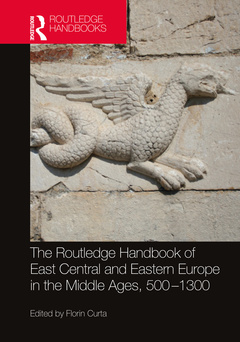The Routledge Handbook of East Central and Eastern Europe in the Middle Ages, 500-1300 Routledge History Handbooks Series
Coordonnateur : Curta Florin

The Routledge Handbook of East Central and Eastern Europe in the Middle Ages, 500?1300 is the first of its kind to provide a point of reference for the history of the whole of Eastern Europe during the Middle Ages.
While historians have recognized the importance of integrating the eastern part of the European continent into surveys of the Middle Ages, few have actually paid attention to the region, its specific features, problems of chronology and historiography. This vast region represents more than two-thirds of the European continent, but its history in general?and its medieval history in particular?is poorly known. This book covers the history of the whole region, from the Balkans to the Carpathian Basin, and the Bohemian Forest to the Finnish Bay. It provides an overview of the current state of research and a route map for navigating an abundant historiography available in more than ten different languages. Chapters cover topics as diverse as religion, architecture, art, state formation, migration, law, trade and the experiences of women and children.
This book is an essential reference for scholars and students of medieval history, as well as those interested in the history of Central and Eastern Europe.
Introduction 1. Situating medieval Eastern Europe: historiography and discontent 2. Between migration and origo gentis: population movements 3. Steppe empires without emperors: Avars, Bulgars and Khazars 4. Medieval nomadism 5. Early conversion to Christianity, Judaism and Islam 6. Conversion to Christianity: Bohemia, Poland, Hungary and Rus’ (9th to 12th centuries) 7. State formation in the 10th century 8. Strongholds and early medieval states 9. The rise of the early medieval aristocracy 10. Rulers between ideal and reality 11. Royal governments 12. Rural economy 13. Crafts, coins and trade (900-1300) 14. Towns and cities 15. Lords, peasants and slaves 16. Women and children 17. Jews, Armenians and Muslims 18. Church organization 19. Saints and relics 20. Heresy and popular religion 21. Crusades and Eastern Europe 22. The Baltic Crusades (1147-1300) 23. Political and practical literacy 24. Law 25. History writing 26. Hagiography 27. Monumental architecture 28. Monumental art 29. New powers - Serbia, Bulgaria 30. The Mongols in Eastern Europe
Florin Curta is Professor of Medieval History and Archaeology at the University of Florida, USA. His books include Southeastern Europe in the Middle Ages, 500–1250 (2006); The Making of the Slavs: History and Archaeology of the Lower Danube, ca. 500–700 (2011), which received the Herbert Baxter Adams Award of the American Historical Association; The Edinburgh History of the Greeks, c. 500 to 1050: The Early Middle Ages (2011); Slavs in the Making: History, Linguistics and Archaeology in Eastern Europe (c. 500 to c. 700) (2021); and The Long Sixth Century in Eastern Europe (2021).
Date de parution : 09-2023
17.4x24.6 cm
Date de parution : 11-2021
17.4x24.6 cm
Thèmes de The Routledge Handbook of East Central and Eastern... :
Mots-clés :
East Central Europe; Medieval Eastern Europe; Otto III; Steppe Empires; Carpathian Basin; Nomadism; Innocent III; Medieval Central Europe; Crusades; Frankish Empire; Christianity; Kievan Rus; Islam; Old Church Slavonic; Judaism; Hasdai Ibn Shaprut; Conversion; Great Moravia; Medieval urbanism; Stefan Nemanja; Otakar II; Son Emeric; Pope Innocent Iii; Staraia Ladoga; Conrad III; Bulgarian Empire; Mieszko II; Origo Gentis; Avar Khaganate; Byzantine Commonwealth; Middle Dnieper Region; Earliest Medieval States; King Coloman; Abd Al Rahman III



